
Owner'sManual
ROUTER
Double Insulated
Model No. 315.175000
Save this manual for future reference

Owner'sManual
ROUTER
Double Insulated
Model No. 315.175000
Save this manual for future reference
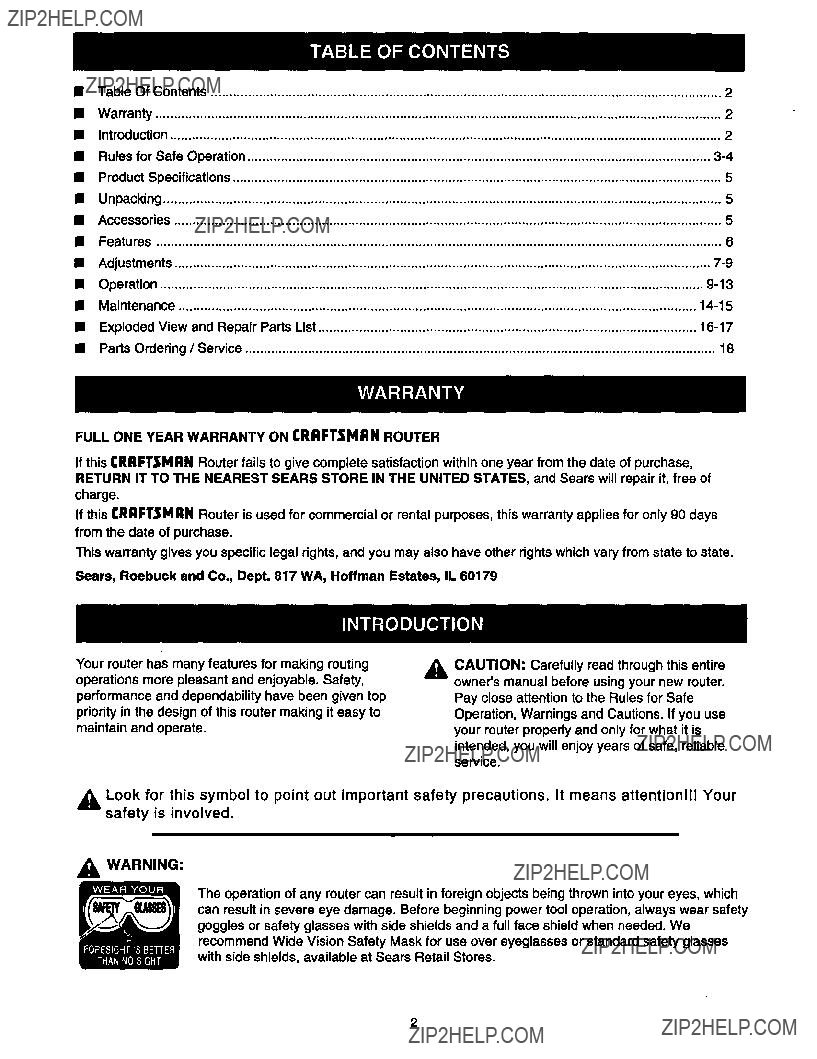
FULL ONE YEAR WARRANTY ON CRAFTSMAN ROUTER
If this CRAFTSMAN Router fails to give complete satisfaction within one year from the date of purchase, RETURN IT TO THE NEAREST SEARS STORE IN THE UNITED STATES, and Sears will repair it, free of
charge.
If this I'RAFTSMRN Router is used for commercial or rental purposes, this warranty applies for only 90 days
from the date of purchase.
This warranty gives you specific legal rights, and you may also have other rights which vary from state to state.
Sears, Roebuck and Co., Dept. 817 WA, Hoffman Estates, IL 60179
_1, Look for this symbol to point out important safety precautions. It means attention!!! Your safety is involved.
_I_ WARNING:
The operation of any router can result in foreign objects being thrown into your eyes, which can result in severe eye damage. Before beginning power tool operation, always wear safety goggles or safety glasses with side shields and a full face shield when needed. We recommend Wide Vision Safety Mask for use over eyeglasses or standard safety glasses with side shields, available at Sears Retail Stores.

The purpose of safety symbols Is to attract your attention to possible dangers. The safety symbols, and the explanations with them, deserve your careful attention and understanding. The safety warnings do not by themselves eliminate any danger. The Instructions or warnings they give are not substitutes for proper accident prevention measures.
SYMBOL MEANING
SAFETY ALERTSYMBOL:
Indicatesdange_waming, orca_ion. M_ used inco_un_onwitho_ersym_lsorpict_raphs.
A
A
DANGER: Failure to obey a safety warning will result in serious injury to yourself or to others. Always follow the safety precautions to reduce the risk of fire, electric shock and personal injury.
WARNING: Failure to obey a safety warning can result in serious injury to yourself or to others. Always follow the safety precautions to reduce the risk of fire, electric shock and personal injury.
CAUTION: Failure to obey a safety waming may result in property damage or personal injury to yourself or to others. Always follow the safety precautions to reduce the risk of fire, electric shock and personal injury.
DOUBLE INSULATION
Double insulation is a concept in safety, in electric power tools, which eliminates the need for the usual
_k WARNING: Do not attempt to operate this tool until you have read thoroughly and understand
completely 'allinstructions, safety rules, etc. contained in this manual. Failure to comply can result in accidents involving fire, electric shock, or serious personal injury. Save owner'smanual and review frequently for continuing safe operation, and instructing others who may use this tool.
READ ALL INSTRUCTIONS
???KNOW YOUR POWER TOOL. Read owner's manual carefully. Learn its applications and limitations as well as the specific potential hazards related to this tool.
???GUARD AGAINST ELECTRICAL SHOCK by preventing body contact with grounded surfaces.
For example; pipes, radiators, ranges, refrigerator enclosures.
???KEEP GUARDS IN PLACE and in working order.
???KEEP WORK AREA CLEAN. Cluttered areas and benches invite accidents.
???AVOID DANGEROUS ENVIRONMENT. Do not use power tools in damp or wet locations or expose to rain. Keep work area well lit.
IMPORTANT
Servicing of a tool with double insulation requires extreme care and knowledge of the system and should be performed only by a qualified service technician. For service we suggest you return the tool to your nearest Sears Store for repair. Always use original factory replacement parts when servicing.
KEEP CHILDREN AND VISITORS AWAY. All visitors should wear safety glasses and be kept a safe distance from work area. Do not let visitors contact tool or extension cord.
???STORE IDLE TOOLS. When not in use, tools should be stored in a dry and high or
???DO NOT FORCE TOOL. It will do the job better and safer at the rate for which it was designed.
???USE RIGHT TOOL. Don'tforce small tool or attachment to do the job of a heavy duty tool. Don'tuse tool for purpose not intended
???WEAR PROPER APPAREL. Do not wear loose clothing or jewelry that can get caught in tool's moving parts and cause personal injury. Rubber gloves and nonskid footwear are recommended when working outdoors. Wear protective hair covering to contain long hair and keep it from being drawn into nearby air vents.
???ALWAYS WEAR SAFETY GLASSES. Everyday eyeglasses have only
???PROTECT YOUR LUNGS. Wear a face or dust mask if the operation is dusty.
3

IPROTECT YOUR HEARING, Wear hearing protection during extended periods of operation,
IDO NOT ABUSE CORD. Never carry tool by cord or yank it to disconnect from receptacle. Keep cord from heat, oil, and sharp edges.
???SECURE WORK. Use clamps or a vise to hold work. It is safer than using your hand and it frees both hands to operate tool.
???DO NOT OVERREACH. Keep proper footing and balance at all times. Do not use on a ladder or unstable support. Secure tools when working at elevated positions.
???MAINTAIN TOOLS WITH CARE. Keep tools sharp and clean for best and safest performance. Follow
instructions for lubricating and changing accesso- des.
???DISCONNECT TOOLS. When not in use, before servicing, or when changing attachments, tools should be disconnected from power supply.
???REMOVE ADJUSTING KEYS AND WRENCHES, Form habit of checking to see that keys and adjusting wrenches are removed from tool before turning it on.
???AVOID ACCIDENTAL STARTING. Do not carry
???MAKE SURE YOUR EXTENSION CORD IS IN GOOD CONDITION. When using an extension cord, be sure to use one heavy enough to carry the current your product will draw. An undersized cord will cause a drop in line voltage resulting in loss of power and overheating. A wire gage size (A.W.G.) of at least 14 is recommended for an extension cord 100 feet or less in length. A cord exceeding 100 feet is not recommended. If in doubt, use the
next heavier gage. The smaller the gage number, the heavier the cord.
???OUTDOOR USE EXTENSION CORDS. When tool is used outdoors, use only extension cords suitable for use outdoors. Outdoor approved cords are marked with the suffix
???KEEP CUTTERS CLEAN AND SHARP. Sharp cutters minimize stalling and kickback.
???KEEP HANDS AWAY FROM ROUTING AREA.
Keep hands away from cutters. Do not reach under- neath work while cutter is rotating. Do not attempt to remove material while cutter is rotating.
???NEVER USE IN AN EXPLOSIVE
ATMOSPHERE. Normal sparking of the motor could ignite fumes.
???INSPECT TOOL CORDS PERIODICALLY and if damaged, have repaired at your nearest Sears
Repair Center. Stay constantly aware of cord
location.
???INSPECT EXTENSION CORDS
PERIODICALLY and replace if damaged.
???KEEP HANDLES DRY, CLEAN, AND FREE FROM OIL AND GREASE. Always use a clean cloth when cleaning. Never use brake fluids, gasoline,
???STAY ALERT AND EXERCISE CONTROL. Watch what you are doing and use common sense. Do not operate tool when you are tired. Do not rush.
???CHECK DAMAGED PARTS. Before further use of the tool, a guard or other pad that is damaged should be carefully checked to determine that it will operate properly and perform its intended function.
Check for alignment of moving parts, binding of moving parts, breakage of parts, mounting and any other conditions that may affect its operation. A guard or other part that is damaged should be
properly repaired or replaced by an authorized service center.
???DO NOT USE TOOL IF SWITCH DOES NOT TURN IT ON AND OFF. Have defective switches replaced by an authorized service center.
???INSPECT FOR and remove all nails from lumber before routing.
???DO NOT operate this tool while under the influence of drugs, alcohol, or any medication.
???POLARIZED PLUGS. To reduce the risk of electric shock, this tool has a polarized plug (one blade is wider than the other). This plug will fit in a polar- ized outlet only one way. If the plug does not fit fully in the outlet, reverse the plug. If it still does not fit, contact a qualified electrician to install the proper outlet. Do not change the plug in any way.
???WHEN SERVICING USE ONLY IDENTICAL
CRAFTSMAN REPLACEMENT PARTS.
???WHEN USING THIS ROUTER WITH A ROUTER
TABLE, HELP PREVENT POSSIBLE SERIOUS
INJURY BY KEEPING THE CUTTER GUARDED AT ALL TIMES. Use only router tables, with guards, that have been designed for use on touters that are of this type, size, and weight.
???DO NOT USE TOOL UNDER "BROWNOUT" OR
OTHER LOW VOLTAGE CONDITIONS. Also, do not use with any device that could cause the power supply voltage to change.
???SAVE THESE INSTRUCTIONS. Refer to them frequently and use them to instruct others who may use this tool. If you loan someone this tool, loan them these instructions also.
SAVE THESE INSTRUCTIONS
4

THE FOLLOWING RECOMMENDED ACCESSORIES ARE
CURRENTLY AVAILABLE AT SEARS RETAIL STORES.

KNOW YOUR ROUTER
See Figure I.
Beforeattemptingto use any tool,familiarize yourself withall operatingfeatures and safety requirements.
SWITCH
To turn your router on, depress the switch trigger. Release switch trigger to turn your router off.
The switch of your router is equipped with a
CHIP SHIELD
A clear plastic chip shield is installed on the front of your router for protection against flying dust and chips. The shield is designed to fit the front opening of the router base. If necessary to remove chip shield,
squeeze the tabs on each end and pull outward. To replace, squeeze the tabs at each end, fit into opening, then release. For your protection, do not use router without chip shield properly In place.
WRENCH STORAGE AREA
Your router has a wrench storage area located on the top end cap portion of the motor housing. When installing or removing cutters, remove the wrench from its storage area. Proper storage of wrench when not in use will help reduce the possibility of losing wrench.
ELECTRICAL CONNECTION
Your router has a precision built electric motor. It should be connected to a power supply that Is 120 volts, 60 Hz, AC only (normal household current). Do not operate this tool on direct current (DC). A substantial voltage drop will cause a loss of power and the motor will overheat. If your router does not operate when plugged into an outlet,
WRENCH
STORAGE
AREA
SPINDLE
HANDLE
SWITCH
WRENCH
A WARNING: Do not allow familiarity with your router to make you careless. Remember that a careless fraction of a second is sufficient to inflict severe injury.
6
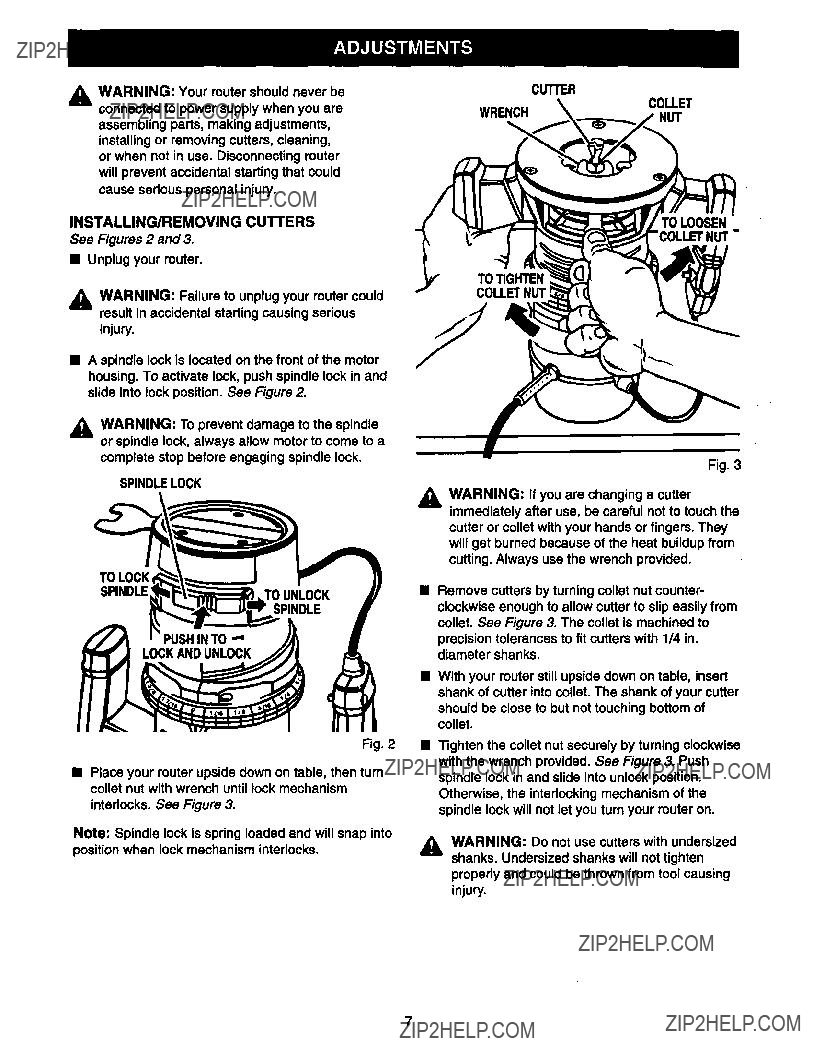
WARNING:Yourroutershouldneverbe
n
connected to power supply when you are assembling parts, making adjustments, installing or removing cutters, cleaning, or when not in use. Disconnecting router will prevent accidental starting that could cause serious personal injury.
INSTALLING/REMOVING CUTTERS
See Figures 2 and 3.
???Unplug your router.
_h, WARNING: Failure to unplug your router could result in accidental starting causing serious
injury.
???A spindle lock is located on the front of the motor housing. To activate lock, push spindle lock in and slide into lock position. See Figure 2.
TO LOOSEN
m
_, WARNING: To prevent damage to the spindle or spindle lock, always allow motor to come to a
complete stop before engaging spindle lock.
SPINDLELOCK
TO LOCK
SPINDLE
Fig. 2
???Place your router upside down on table, then turn collet nut with wrench until lock mechanism interlocks. See Figure 3.
Note: Spindle lock is spdng loaded end will snap into
position when lock mechanism interlocks.
Fig. 3
_k WARNING: If you are changing a cutter immediately after use, be careful not to touch the
cutter or collet with your hands or fingers. They will get burned because of the heat buildup from cutting. Always use the wrench provided.
???Remove cutters by turning collet nut counter- clockwise enough to allow cutter to slip easily from collet. See Figure 3. The collet is machined to precision tolerances to fit cutters with 1/4 in. diameter shanks.
???With your router still upside down on table, insert shank of cutter into collet. The shank of your cutter should be close to but not touching bottom of collet.
Tighten the collet nut securely by turning clockwise with the wrench provided. See Figure 3. Push spindle lock in and slide into unlock position. Otherwise, the interlocking mechanism of the spindle lock will not let you turn your router on.
,_ WARNING: Do not use cutters with undersized shanks. Undersized shanks will not tighten
properly and could be thrown from tool causing injury.
7
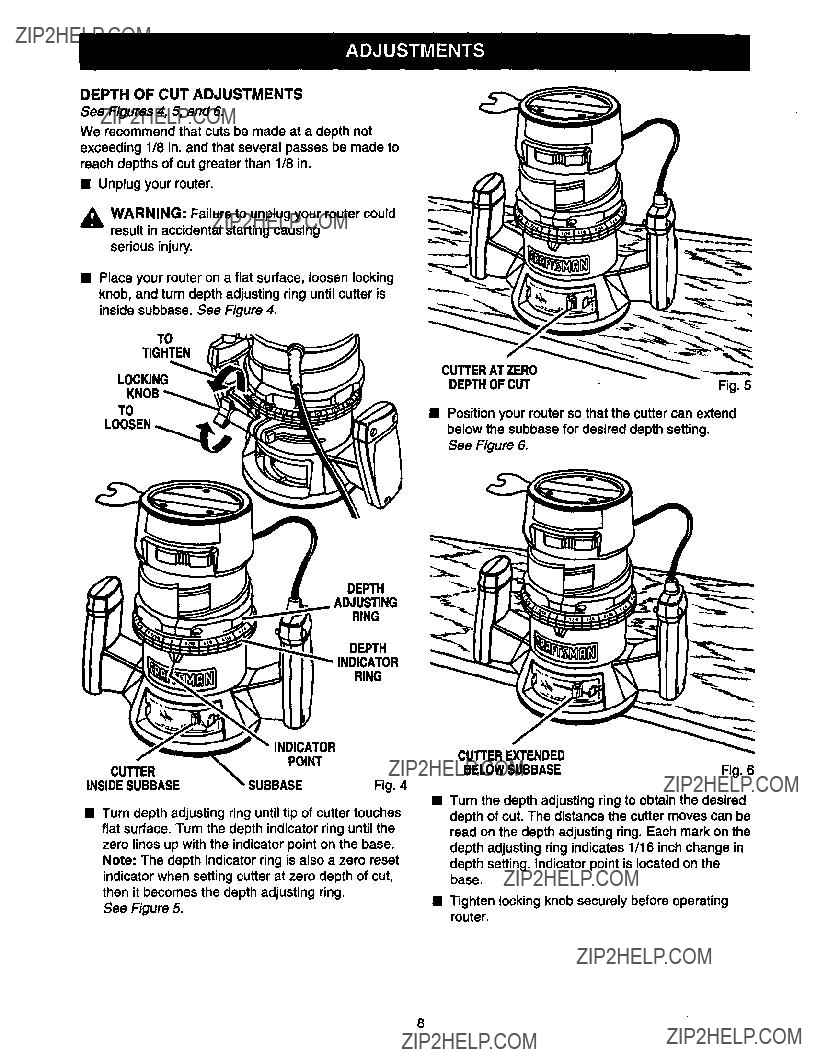
DEPTH OF CUT ADJUSTMENTS
See Figures 4, 5, and 6.
We recommend that cuts be made at a depth not exceeding 1/8 in. and that several passes be made to reach depths of cut greater than 1/8 in.
???Unplug your router.
_k WARNING: Failure to unplug your router could result in accidental starting causing
serious injury.
???Place your router on a flat surface, loosen locking knob, and turn depth adjusting ring until cutter is inside subbase. See Figure 4.
DEPTH
ADJUSTING
RING
DEPTH
INDICATOR
RING
???Turn depth adjusting ring until tip of cutter touches flat surface. Turn the depth indicator ring until the zero lines up with the indicator point on the base. Note: The depth indicator ring is also a zero reset indicator when setting cutter at zero depth of cut, then it becomes the depth adjusting ring.
See Figure 5.
???Tum the depth adjusting ring to obtain the desired depth of cut. The distance the cutter moves can be read on the depth adjusting ring. Each mark on the depth adjusting ring indicates 1/16 inch change in depth setting. Indicator point is located on the base.
???Tighten locking knob securely before operating router.
8
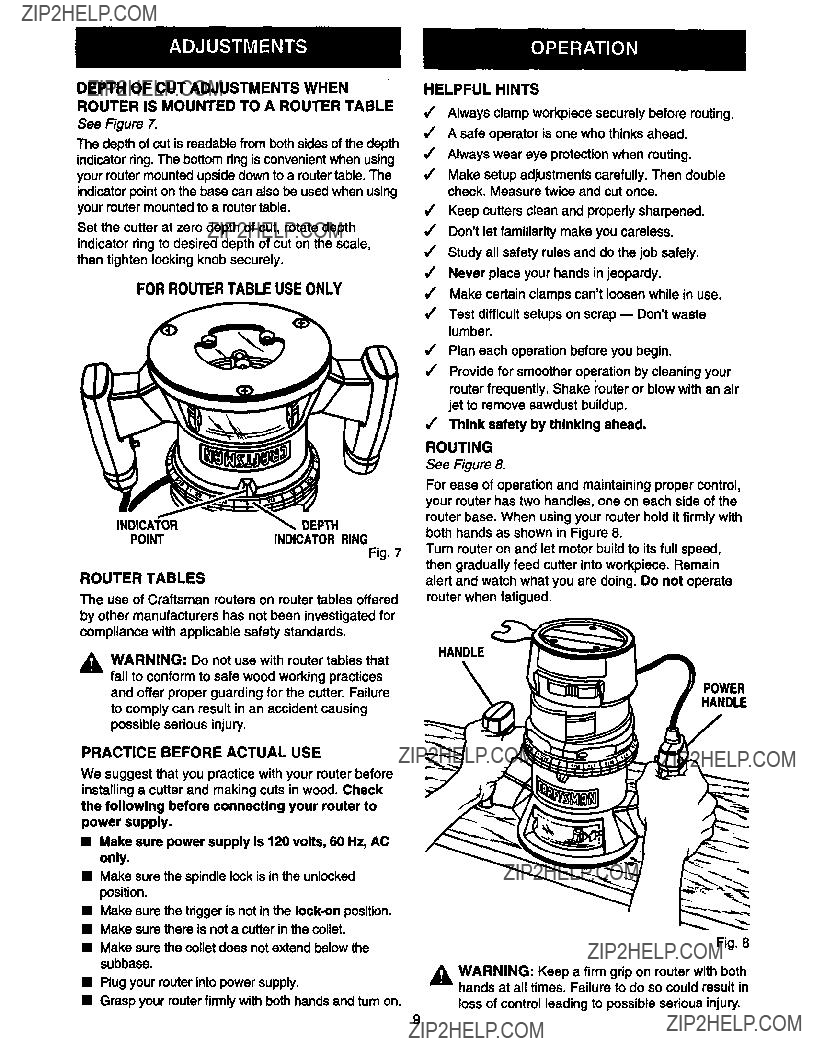
DEPTH OF CUT ADJUSTMENTS WHEN
ROUTER IS MOUNTED TO A ROUTER TABLE
See Figure 7.
The depth of cut is readable from both sides of the depth indicator ring. The bottom ring is convenient when using your router mounted upside down to a router table. The indicator point on the base can also be used when using your router mounted to a router table.
Set the cutter at zero depth of cut, rotate depth indicator ring to desired depth of cut on the scale, then tighten locking knob securely.
FORROUTERTABLEUSEONLY
ROUTER TABLES
The use of Craftsman routers on router tables offered by other manufacturers has not been investigated for compliance with applicable safety standards,
,_ WARNING: Do not use with router tables that fail to conform to safe wood working practices
and offer proper guarding for the cutter. Failure to comply can result in an accident causing possible serious injury.
PRACTICE BEFORE ACTUAL USE
We suggest that you practice with your router before installing a cutter and making cuts in wood. Check the following before connecting your router to power supply.
???Make sure power supply Is 120 volts, 60 Hz, AC only.
???Make sure the spindle lock is in the unlocked position.
???Make sure the trigger is not in the
???Make sure there is not a cutter in the ccllet.
???Make sure the collet does not extend below the subbase.
???Plug your router into power supply.
???Grasp your router firmly with both hands and turn on.
J Make certain clamps can'tloosen while in use.
,/ Test difficult setups on scrap
V" Plan each operation before you begin.
/Provide for smoother operation by cleaning your router frequently. Shake router or blow with an air
jet to remove sawdust buildup.
J' Think safety by thinking ahead.
ROUTING
See Figure 8.
For ease of operation and maintaining proper control, your router has two handles, one on each side of the router base. When using your router hold it firmly with both hands as shown in Figure 8.
Tum router on and let motor build to its full speed, then gradually feed cutter into workpiece. Remain alert and watch what you are doing. Do not operate router when fatigued.
HANDLE
,OWER
Fig. 8
_1= WARNING: Keep a firm grip on router with both hands at all times. Failure to do so could result in
loss of control leading to possible serious injury.
9
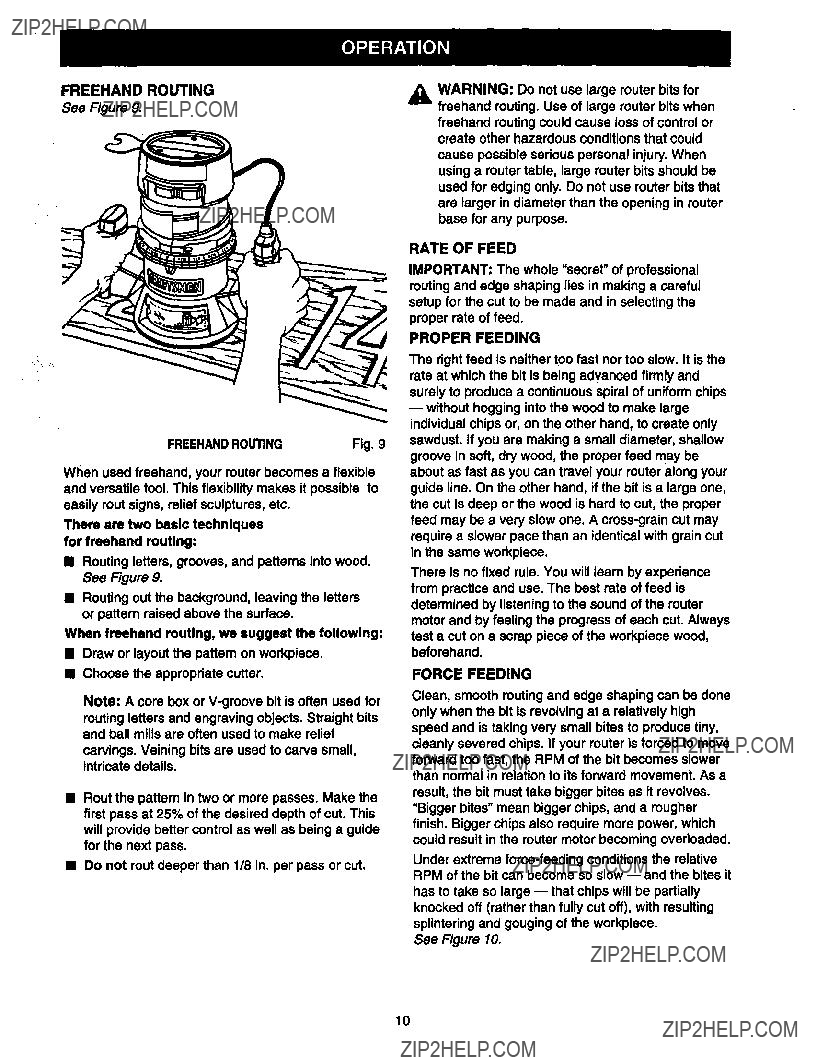
FREEHANDROUTING
See Figure 9.
FREEHANDROUTINGFig. 9
When used freehand, your router becomes a flexible and versatile tool. This flexibility makes it possible to easily rout signs, relief sculptures, etc.
There are two basic techniques for freehand routing:
iRouting letters, grooves, and patterns into wood.
See Figure 9.
???Routing out the background, leaving the letters or pattem raised above the surface.
When freehand routing, we suggest the following:
???Draw or layout the pattem on workpiece.
???Choose the appropriate cutter.
Note: A core box or
Rout the pattem in two or more passes. Make the first pass at 25% of the desired depth of cut. This will provide better control as well as being a guide for the next pass.
???Do not rout deeper than 1/8 in. per pass or cut.
&WARNING: Do not use large router bits for freehand routing. Use of large router bits when
freehand routing could cause loss of control or create other hazardous conditions that could cause possible serious personal injury. When using a router table, large router bits should be used for edging only. Do not use router bits that are larger in diameter than the opening in router base for any purpose.
RATE OF FEED
IMPORTANT: The whole Usecret" of professional routing and edge shaping lies in making a careful setup for the cut to be made and in selecting the proper rate of feed.
PROPER FEEDING
The right feed is neither too fast nor too slow. It is the rate at which the bit is being advanced firmly and surely to produce a continuous spiral of uniform chips
There is no fixed rule. You will leam by experience from practice and use. The best rate of feed is determined by listening to the sound of the router motor and by feeling the progress of each cut. Always test a cut on a scrap piece of the workpiece wood, beforehand.
FORCE FEEDING
Clean, smooth routing and edge shaping can be done only when the bit is revolving at a relatively high speed and is taking very small bites to produce tiny, cleanly severed chips. If your router is forced to move forward too fast, the RPM of the bit becomes slower than normal in relation to its forward movement. As a result, the bit must take bigger bites as it revolves. _Bigger bites" mean bigger chips, and a rougher finish. Bigger chips also require more power, which could result in the router motor becoming ovedoaded.
Under extreme
See Figure 10.
10

TOOFAST
TOOSLOWFig.10
Yourrouter is an extremely
RPM
You can always detect "force feeding" by the sound of the motor. Its
TOO SLOW FEEDING
It is also possible to spoil a cut by moving the router forward too slowly. When it is advanced into the work too slowly, a revolving bit does not dig into new wood fast enough to take a bite; instead, it simply scrapes away
In addition, it is more difficult to control a router when the bit is scraping instead of cutting. With practically no load on the motor the bit will be revolving at close to top RPM, and will have a much greater than normal tendency to bounce off the sides of the cut (especially if the wood has a pronounced grain with hard and soft areas). As a result, the cut produced may have rippled, instead of straight sides. See Figure 10.
Always grasp and hold your router firmly with both hands when routing.
You can detect
DEPTH OF CUT
As previously mentioned, the depth of cut is important because it affects the rate of feed which, in tum, affects the quality of a cut (and, also, the possibilityof damage to your router motor and bit). A deep cut requires a slower feed than a shallow one, and a too deep cut will cause you to slow the feed so much that the bit is no longer cutting, it is scraping, instead.
Making a deep cut is never advisable. The smaller
are easily broken off when subjected to too much side thrust. A large enough bit may not be broken off, but if the cut is too deep a rough cut will result
For these reasons, we recommend that you do not exceed 1/8 inch depth of cut in a single pass, regardless of the bit size or the softness or condition of the work,piece. See Figure 1I.
DEPTH
OF cur
WIDTH
Fig. 11
11

Tomakedeepercutsit isthereforenecessaryto makeasmanysuccessivepassesasrequired, loweringthebit118inchfor each new pass. In order to
save time, do all the cutting necessary at one depth setting, before lowering the bit for the next pass. This will also assure a uniform depth when the final pass is completed. See Figure 12.
Fig. 12
DIRECTION OF FEED AND THRUST
The muter motor and bit revolve in a clockwise dirc- tion. This gives the tool a slight tendency to twist (in your hands) in a counterclockwise direction, especially when the motor revs up (as at starting).
Because of the extremely high speed of bit rotation during a =proper feeding" operation, there is very little kickback to contend with under normal conditions. However, should the bit stdke a knot, hard grain, foreign object, etc. that would affect the normal
pr gress of the cutting action, there will be a slight kickback p sufficient to spoil the trueness of your cut if you are not prepared. Such a kickback is always in the direction opposite to the direction of bit m tation.
To guard against such a kickback, plan your setup and direction of feed so that you will always be thr sting the tool
ROUTING
Whenever you are muting a groove, your travel should be in a dir ction that places whatever guide you are using at the
Figure 13, tool travel should be left to right and counter Iockwise arund curves. When the guide is positioned as shown in the second part of Figure 13, tool travel should be right to left and clockwise around curves. If there is a choice, the first setup is generally the easiest to use. In either case, the sideways thrust you use is against the guide.
GUIDEOUTSIDE
ROTATION
THRUST
ROTATION
GUIDEFEED
GUIDEINSIDE
THRUST
12

STARTING AND ENDING A CUT
INTERNAL ROUTING
Tilt router and place on workpiece, letting edge of subbase contact workpiece first. Be careful not to let router bit contact workpiece. Turn router on and let motor build to its full speed. Gradually feed cutter into workpiece until subbase is level with workpiece.
WARNING: Keep a firm grip on router with both hands at all times. Failure to do so could result in
loss of control leading to possible serious injury.
Upon completion of cut, tum motor off and let it come to a complete stop before removing router from work surface.
,_ WARNING: Never pull router out of work and place upside down on work surface before the
cutter stops.
EDGING WITH PILOT BITS
See Figure14.
Whenever the workpieco thickness together with the desired depth of cut (as adjusted by router depth setting) are such that only the top part of the edge is to be shaped (leaving at least a 1/16 inch thick uncut portion at bottom), the pilot can ride against the uncut portion, which will serve to guide it. See Figure 14.
However, if the workpiece is too thin or the bit set too low so that there will be no uncut edge to ride the pilot against, an extra board to act as a guide must be placed under the workpiece. This =guide"board must have exactly the same contour
Note: Any of the piloted bits can be used without a pilot for edge shaping with guides, as preceding, The size (diameter) of the pilot that is used determines the maximum cut width that can be made with the pilot against the workpiece edge - the small pilot exposes all of the bit; the large one reduces this amount by 1/16 inch.
TOP EDGE SHAPING
J,
PILOT
WHOLEEDGESHAPING Fig.14
EDGE ROU_NG
Place router on workpiece, making sure the router bit does not contact workpiece. Tum router on and let motor build to its full speed. Begin your cut, gradually feeding cutter into workpiece.
_1= WARNING: Keep a firm grip on router with both hands at all times. Failure to do so could result in
loss of control leading to possible sadous injury.
Upon completion of cut, tum motor off and let it come to a complete stop before removing router from work surface.
,_ WARNING: Never pull router out of work and place upside down on work surface before the
cutter stops.
ROUTING WITH GUIDE BUSHINGS
When using the Template Guide Bushings Item No.
13

_i WARNING: When servicing, use only identical
Craftsman replacement parts. Use of any other part may create a hazard or cause product damage.
GENERAL
Only the parts shown on parts list, page 17, are intended to be repaired or replaced by the customer. All other parts represent an important part of the double insulation system and should be serviced only by a qualified Sears service technician.
Avoid using solvents when cleaning plastic pads. Most plastics are susceptible to damage from various types of commercial solvents and may be damaged by their use. Use clean cloths to remove dirt, carbon dust, etc.
_, WARNING: Do not at any time let brake fluids, gasoline,
oils, etc. come in contact with plastic pads. They contain chemicals that can damage, weaken or destroy plastic.
It has been found that electric tools are subject to accelerated wear and possible premature failure when they are used on fiberglass boats, sports cars, wallboard, spackling compounds, or plaster. The chips and grindings from these materials are highly abrasive to electdc tool parts such as bearings,
brushes, commutators, etc. Consequently, it is not recommended that this tool be used for extended
work on any fiberglass material, wallboard, spackling compounds, or plaster. During any use on these materials it is extremely important that the tool is cleaned frequently by blowing with an air jet.
LUBRICATION
All of the bearings in this tool are lubricated with a sufficient amount of high grade lubricant for the life of the unit under normal operating conditions. Therefore, no further lubrication is required.
EXTENSION CORDS
The use of any extension cord will cause some loss of power. To keep the loss to a minimum and to prevent
tool overheating, use an extension cord that is heavy enough to carry the current the tool will draw.
A wire gage size (A.W.G.) of at least 14 is recommended for an extension cord 100 feet or less in length. When working outdoors, use an extension
cord that is suitable for outdoor use. The cord'sjacket will be marked WA.
CAUTION: Keep extension cords away from the cutting area and position the cord so that it will
not get caught on lumber, tools, etc., during cutting operation.
WARNING: Check extension cords before each use, If damaged replace immediately. Never use tool with a damaged cord since touching the damaged area could cause electrical shock resulting in serious injury,
Extension cords suitable for use with your router are available at your nearest Sears Retail Store.
&WARNING: Always wear safety goggles or safety glasses with side shields during power
tool operation or when blowing dust. If operation is dusty, also wear a dust mask.
PROPER CARE OFCUTTERS
Get faster more accurate cutting results by keeping cutters clean and sharp. Remove all accumulated pitch and gum from cutters after each use.
When sharpening cutters, sharpen only the inside of the cutting edge. Never grind the outside diameter. Be sure when sharpening the end of a cutter to grind the clearance angle the same as originally ground.
PROPER CARE OFCOLLET
From time to time, it also becomes necessary to clean your collet and collet nut. To do so, simply remove collet nut from collet and clean the dust and chips that have collected. Then return collet nut to its original position.
14

SWITCHREPLACEMENT
See Figures 15 and 16.
???Unplug your router.
WARNING: Failure to unplug your router could result in accidental starting causing
serious injury.
???Remove screws (A) and handle cover (B).
See Figure 15.
A
Fig. 15
???Note the location of the molded bend relief (C)
on the power handle cord. Also note all wiring In the handle and how each lead Is connected
to the switch. Connections and wiring position must be identical when installing new switch.
See Figure 15.
???Remove leads from switch (D) by inserting a 1/32 in. diameter nail or pin into switch lead receptacle and pulling on lead as shown in Figure 16.
Remove nail or pin with a twisting, pulling motion.
LEAD
POWER
HANDLE
CORDWORK
UGHT
1/32 In. DIAMETER
NAILOR PIN
RED
Fig. 16
???Make lead connections to new switch. Push each lead as far as possible into proper switch receptacle. Pull on leads to check lead connections with lead receptacles.
???Locate switch in handle end place leads so they won'tbe pinched or contact screws when handle cover is replaced.
???Make sure molded bend relief (C) is correctly
positioned in switch handle, then replace handle cover and screws.
???Tighten allscrewssecurely.
LIGHT BULB REPLACEMENT
See Figure 17.
???Unplug your router.
_1, WARNING: Failure to unplug your router could result in accidental starting causing serious
injury.
???Remove cutter from router. Refer to page 7 to remove cutter.
???Adjust router to maximum height.
???Remove screws (A) and subbase (B),
See Figure 17,
c\
Fig. 17
???Remove screw (C) and work light lens (D).
???With bulb (E) pointing toward you, push bulb in and tum to the left to remove from bulb socket.
Note: Light bulb removal and installation is similar
to removing and installing a standard automotive bulb.
???Install new bulb by reversing the above procedure.
???Reassemble all parts and tighten screws securely.
15

CRAFTSMAN ROUTER - MODEL NUMBER 315.175000,
SEE NOTE"A"
9
10
11
_q
NOTE: "A" - The assembly shown represents an Important part of the Double Insulated System. To avoid the poselblllty of alteretlon or damage to the System, service should be performed by your nearest Sears Repair Center. Contact your nearest Sears Retail Store for Service Center Information.
16

CRAFTSMAN ROUTER - MODEL NUMBER 315.175000
SEE BACK PAGE FOR PARTS ORDERING INSTRUCTIONS
2
3
4
5
6
7
8
9
10
11
12
13
14
15
16
17
18
19
20
21
22
23
24
25
26
27
PARTS LIST
* Standard Hardware Item - May Be Purchased Locally
17

In U.S.A. or Canada
for
Pars pedir servicio de reparaci6n a domicilio -
Au Canada pour tout le service ou les pi_ces -
For the repair or replacement parts you need:
Call 6 a.m. - 11 p.m. CST, 7 days a week
Parts Direct "
Pars ordenar piezas con entrega a domicilio -
For the location of a Sears Service Center in your area: Call 24 hours a day, 7 days a week
To purchase or inquire about a Sears Maintenance Agreement: Call 7 a.m. - 5 p.m. CST, Monday - Saturday
p.-
b_
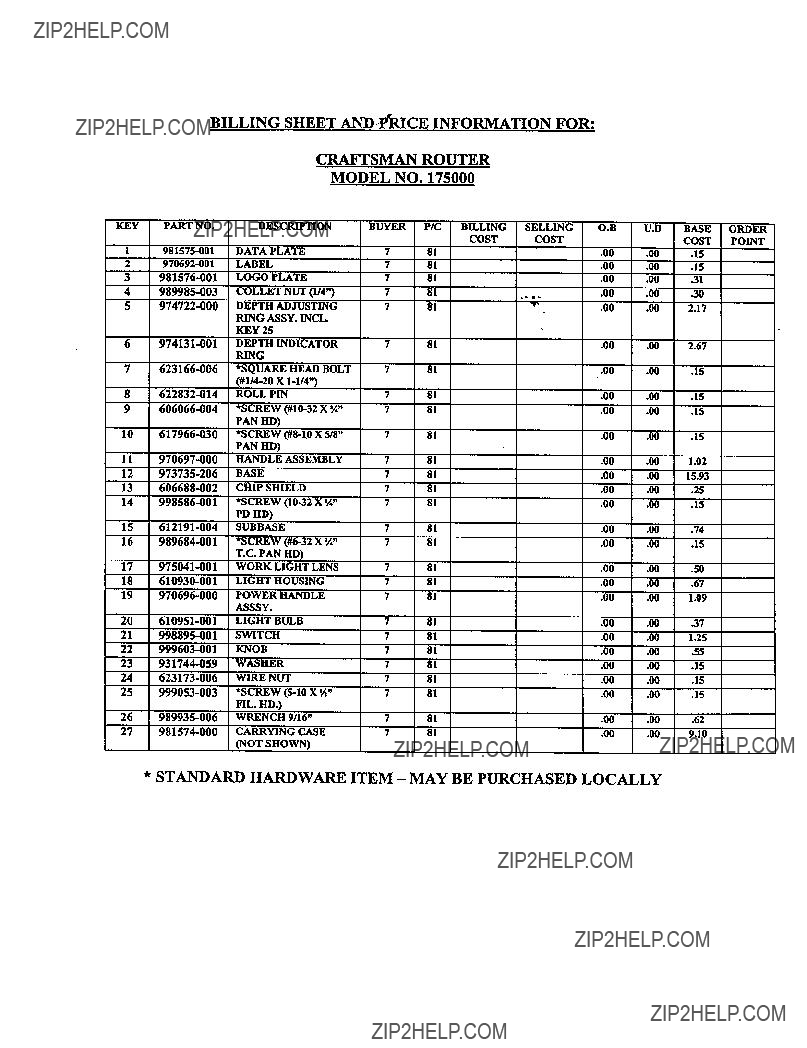
BILLING SHEET AND I_RICE INFORMATION FOR:
CRAFTSMAN ROUTER
MODEL NO. 175000
KEY PART NO.
1
2
3
4
5
10
11
12
13
14
15
16
17
18
19
20
21
22
23
24
25
26
27
* STANDARD HARDWARE ITEM - MAY BE PURCHASED LOCALLY

* STANDARD HARDWARE ITEM - MAY BE PURCHASED LOCALLY